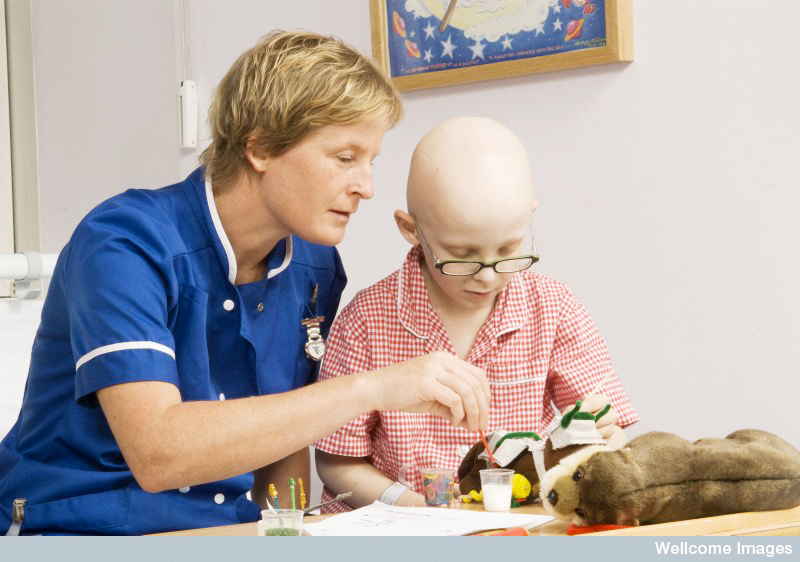Over the last decade, advances in technology have triggered an explosion in our knowledge about the biology of adult cancers – but we know far less about what causes cancers in children. Gaps in our understanding of how to target children’s cancers have too often left doctors reliant on use of old-style, non-specific chemotherapy drugs designed for adults. But the side-effects of these drugs can be devastating for children: growth abnormalities, cosmetic deformity, and secondary cancers and infertility in later life. Here at The Institute of Cancer Research, London, we are helping lead the fight-back, by pioneering the design and testing of new targeted therapies specifically designed to combat childhood cancer.
Dr Louis Chesler, Team Leader in Paediatric Solid Tumour Biology and Therapeutics at The Institute of Cancer Research (ICR) and Honorary Consultant in Paediatric Oncology at The Royal Marsden , is part of the effort, striving to develop safer, more effective treatments for childhood cancer. “Our team work with a group of paediatric cancers that are very tricky to cure – brain tumours, peripheral nerve tumours called neuroblastomas and muscle tumours,” Dr Chesler explains. “Of the numerous genetic changes that occur in children with these cancers, changes in a gene called MYCN are very important. Normal expression of this gene is necessary for development of the brain and nervous system but abnormal or uncontrolled expression can cause cancers in these same tissues. Once we have understood that a gene like MYCN could potentially cause cancer, we can begin to tease out the cellular pathways that transmit the cancer-causing signals, in order to design drugs that specifically target the activity of genes of this type. We now have the knowhow and technology to design drugs that will attack single cancer proteins – so-called precision medicines.”
Another gene implicated in driving neuroblastoma is the ALK gene. Patients with abnormal ALK frequently also have alterations to the MYCN gene, and an aggressive form of neuroblastoma that is notoriously difficult to treat with conventional drugs. Crizotinib, a drug already licensed for use in adults, targets the ALK gene and has shown positive early results in its first clinical trial in children with cancers, including neuroblastoma. But early experience suggests that these tumours eventually stop responding to treatment after developing additional mutations in the ALK gene targeted by the drug. This is similar to the situation that occurred in the past with the first targeted treatment ever developed, which used Gleevec to treat an adult cancer called chronic myelogenous leukaemia. Resistance develops quickly, and this appears to be the case with crizotinib as well.
Dr Chesler’s team have come up with a new strategy of combining crizotinib with a second class of drugs – mTOR inhibitors – to overcome the resistance of cancer cells. Dr Chesler says: “Combined changes in the ALKand MYCN genes led to more aggressive crizotinib-resistant neuroblastoma because ALK switches on a pathway called PI3K/AKT/mTOR. But giving an mTOR inhibitor with crizotinib prevents the growth of neuroblastoma by simultaneously inhibiting the ALK and MYCN genes, overcoming the resistance of these tumours to treatment with crizotinib alone.
It is a hope of Dr Chesler that one day, a drug developed in his laboratory will lead to clinical trials that will improve survival in paediatric cancer. “Our current work is on the right track to achieving that goal,” he says. “Ideally I would like to develop a one-a-day pill that would be free of side-effects and would be very effective against a children’s cancer, or maybe even prevent the development of the cancer completely. This sounds unrealistic but it has already been achieved for an adult cancer – we need a Gleevec for children.”
Dr Chesler’s work is part of a new clinical strategy to directly target cancer-causing genes in childhood cancer, using drugs designed specifically for children. More effective, targeted therapies mean that the harsh side-effects of more non-specific and aggressive treatments will be minimised. “The impact of curing paediatric cancer in terms of years of lives saved is infinitely greater in a child,” says Dr Chelser. “If you cure a lethal cancer in a five-year-old child, you have the potential to give them a long, healthy life, free of side-effects. Seeing patients growing up, living their dreams and seeing them have their own children is amazing, the most rewarding thing of all.”
